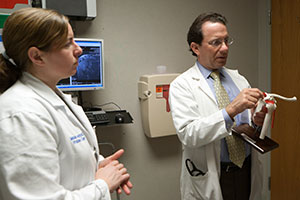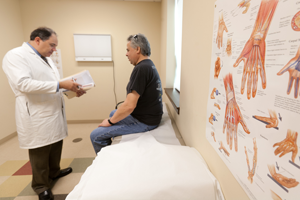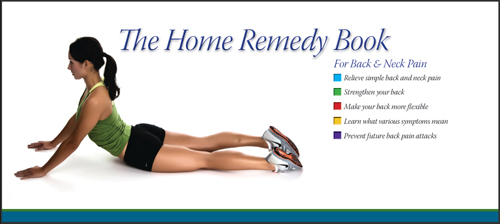- Locations
- Find a Physician
- By Physician
- By Department
- The Center for Spine Health
- Hand & Wrist Center
- Shoulder & Elbow Center
- Foot & Ankle Center
- Joint Replacement Center
- The Sports Medicine Center
- Pediatric Orthopedic Center
- Trauma & Fracture Center
- Osteoporosis and Bone Health
- Oncology Center
- Cartilage Repair Center
- Concussion Rehab Center
- OrthoDirect
- Careers
- Patient Portal
- Intranet
 Shoulder Pain
Shoulder Pain
 The shoulder consists of several joints that combine with tendons and muscles to permit a full range of motion to the arm. The shoulder movement can cause increasing problems with instability or impingement of soft tissue leading to pain. Pain might be acute and quickly disappear or it may continue and require medical diagnosis and treatment.
The shoulder consists of several joints that combine with tendons and muscles to permit a full range of motion to the arm. The shoulder movement can cause increasing problems with instability or impingement of soft tissue leading to pain. Pain might be acute and quickly disappear or it may continue and require medical diagnosis and treatment.
The most flexible joint in the entire human body is the shoulder. The shoulder joint is formed by the union of the humerus, the scapula (shoulder blade), and the clavicle (collarbone). The shoulder is made up of the glenohumeral and acromioclavicular joints.
These joints work together to allow the arm to move in a large circle and to rotate around its axis at the shoulder. The top of the upper arm bone fits into a rounded socket in the shoulder blade. This socket is known as the glenoid. The muscles and tendons keep the arm bone centered in the shoulder socket. These tissues are known as the rotator cuff. The rotator cuff cover the top of the upper arm bone and attach it to the shoulder blade. The primary function of the rotator cuff is to raise and lower the arm. Shoulder problems typically involve soft tissues injuries to muscles, tendons or ligaments.
Common causes of pain
Rather than bones, many shoulder problems involve the soft tissues, muscles, ligaments, and tendons. These problems usually fall into three major categories including tendonitis or bursitis, injury and instability, and arthritis. Other much more rare causes of shoulder pain are tumors, infection and nerve-related problems.
- Tendonitis
- Rotator Cuff Tears
- Injury or Instability
- Dislocated Shoulder
- Bursitis
- Arthritis
Tendonitis
Tendons help connect muscle to bone or other tissue. Most tendinitis is a result of the wearing process that takes place over a period of years. Typically, tendinitis is either acute tendonitis or chronic tendonitis. Acute tendonitis is usually from some overuse problem. Chronic tendonitis can be attributed to degenerative disease or repetitive wear. The splitting and tearing may result from acute injury or degenerative disorders. The most common of these disorders are rotator cuff injuries. The rotator cuff is composed of muscles and tendons that provide shoulder motion and stability.
Bursitis

In some cases, excessive use of the shoulder leads to inflammation and swelling of a bursa, a condition called bursitis. Bursas are often described as fluid-filled sacs located around the joints which lessen the friction caused by movement of the shoulder. Bursitis usually occurs in association with rotator cuff tendinitis. Sometimes the many tissues in the shoulder become inflamed and painful, which in turn may limit the use of the shoulder. The joint may stiffen as a result, a condition known as a "frozen shoulder." The good news is that with appropriate care, this condition will usually resolve itself.
Injury / Instability
Sometimes the bones in one of the shoulder joints move (or, in an injury, are forced) out of their normal position. This condition, instability, can result in dislocation of one of the joints in the shoulder. Recurring dislocations, which may be partial or complete, cause pain and unsteadiness when you raise your arm or move it away from your body. When you lift your arm over your head, the shoulder may feel as if it is slipping out of place or an uncomfortable, unusual feeling that some people refer to as having a "dead" arm.

Arthritis
Shoulder pain may also result from arthritis. There are many types of arthritis, but generally it involves wear and tear changes with inflammation of the joint, causing swelling, pain and stiffness. Arthritis may be attributed to sports or work injuries.
People will often avoid shoulder movements in an attempt to lessen the pain arising from these conditions. Unfortunately, this can lead to a tightening or stiffening of the soft tissue parts of the joint, resulting in a painful restriction of motion.
Dislocated Shoulder
If you have a dislocated shoulder, it can either be partially dislocated or fully dislocated. This can happen from falling or contact sports like football or hockey. Sharp twisting of the arm can dislocate a shoulder by pulling the arm out of the shoulder socket. It could swell up, become numb, weak, bruise and the shoulder needs to be treated right away. Your doctor will need to move the arm bone back into the shoulder socket. When the arm is repositioned back into the socket, some of the pain will diffuse. You can use conservative treatment to reduce pain and swelling.
Rotator Cuff Tears
As the most flexible joint in the body, the shoulder is capable of performing a wide range of activities. However, with this incredible range of motion, it is at high risk for instability which can lead to pain. Overuse can lead to rotator cuff tears. Causes of a rotator cuff tear can be improper lifting, falling down, or repetitive strain on the shoulder. Treating a rotator cuff non surgically may be appropriate depending on the severity of the injury. In many cases, the best thing to do is administer RICE (rest from the activity causing the pain, apply ice to the injured area, compress the injured area, and elevate the injured area above the heart to reduce swelling by forcing the fluid to go downhill away from the injured joint). When it hurts to sleep on the affected shoulder, lifting the arms is uncomfortable, the pain resides in the dominant arm or the affected shoulder continues to make noises, it is time to see an orthopedic specialist.
Shoulder / Bicep Tendon Repair
The shoulder is a ball-and-socket joint made up of three bones: the humerus (upper arm bone), scapula (shoulder blade), and clavicle (collarbone).
Tendons help attach muscles to bones. The biceps muscle has two tendons, one of which attaches it to the bone in the shoulder and the other attaches at the elbow. The biceps help in bending your elbow, rotational movement of the forearm, and help stabilize the shoulder joint.
If a tear occurs at the biceps tendon at the shoulder, you will experience pain in the shoulder area but most people can still function and only need simple treatments to alleviate the symptoms.
However, surgery to repair the torn tendon may be required if symptoms cannot be relieved by nonsurgical treatments. Once a biceps tendon is torn, it cannot regrow back to the bone and heal by itself.
Biceps tendon tears can become either a partial tear or complete tear. A partial tear is when the tendon has not been fully severed. A complete tear includes the tendon splitting into two complete sections. In most cases, a damaged tendon will slowly begin fraying, and as the injury worsens, the tendon may completely tear when put under stress, such as lifting a heavy object. The two most common causes for biceps tendon tears include injury and overuse.
Some of the symptoms of a damaged shoulder or bicep tendon include pain in the upper arm, audible popping sound, bruising, tenderness, or a bulge in the upper arm area above the elbow.
Most people can recover without surgery from a shoulder or bicep tendon tear. The pain from a biceps tendon tear can resolve itself over time and minor arm weakness may never bother the patient. Some of the recommended therapies to help your shoulder or bicep tendon tear heal include rest, ice, nonsteroidal anti-inflammatory medications like ibuprofen, and even frequent physical therapy exercises to help increase flexibility, strengthen the shoulder, and help restore movement.
Surgical treatment for a biceps tendon tear is rarely needed. For the patients that continue to experience pain and excessive weakness in their arm, surgery may be the only option. Surgery can be the best option for people who need their arm to hold under daily stress, such as athletes. Surgery may also be the best option for patients with partial tears whose symptoms are not getting better with nonsurgical treatment.
There are minimally invasive surgical procedures that provide the option of repairing the tendon with minimal incisions. The surgeon will use an arthroscopic camera and tools to re-anchor the torn tendon back to the bone. Successful surgery can return the arm's strength and function to normal.
There are several procedures to accomplish reattachment of the biceps tendon to the forearm bone. Some techniques require the tendon to be reattached using stitches passed through holes drilled in the bone, and other times a small metal implant may be used to reattach the tendon.
A biceps tendon repair requires the surgeon to make a small incision over the upper forearm. The torn biceps tendon is brought up through the incision. Two suture anchors for the tendon will be inserted into the bone. The sutures from the suture anchors are passed through the tendon in an interlocking manner to ensure a strong tendon repair.
After the repair is complete, an elbow sling / brace will be use to keep the elbow bent at 90 degrees. The brace will be removed after 4-6 weeks and it may take up to 6-12 months to regain full strength.
It is important to keep the shoulder immobilized after surgery, and slowly begin therapeutic and rehabilitation exercises to build back the strength into the shoulder area. Although it is a slow recovery, physical therapy is vital in order for the patient to develop the original strength back into the shoulder / elbow and return to strenuous activities.
Arthroscopic Rotator Cuff Repair
Arthroscopy is a minimally invasive technique that uses a camera, tiny incision holes, and specialized tools that allow the orthopedic surgeon to fix rotator cuff tears usually through 3-4 very small incisions. This drastically speeds up recovery time and is less intrusive on the body. The rotator cuff tear is repaired by suturing the torn tendon back to the humerus. Recovery is less painful and scars are less noticeable. During surgery for a rotator cuff tear, the surgeon removes debris from the damaged shoulder cuff tendon. This is called a debridement and is completed arthroscopically. If bone spurs are present, the surgeon will next smooth the acromion area to prevent the acromion from pinching the tendon.
Arthroscopic rotator cuff repair reattaches torn tendons in the shoulder. Small incisions are made around the shoulder and a camera is inserted. The surgeon will perform a debridement, which removes any debris from the cuff tendon. Throughout the process the surgeon will determine how much surgery actually needs to be performed based on the condition of the shoulder. The surgeon may need to smooth down the bottom of the acromion if bone spurs have formed. If there is a torn rotator cuff tendon, a small area on the humerus is cleared and anchors are screwed into place to hold the stitches in place on the arm bone. The tendon is stitched together and pulled against the anchors for support. This procedure reattaches the tendon to the humerus. Your bone will naturally reattach the tendon to the humerus bone and physical therapy will be needed to regain strength in the shoulder.
Shoulder Treatment and Surgery
Most common shoulder problems can be managed successfully without surgery. For problems and injuries that can’t be treated non-surgically, the patient may have to undergo surgery to fix the issue.
Shoulder surgeries can include:
- Total Shoulder Replacement Surgery
- Reverse Shoulder Replacement
- Rotator Cuff Surgery / Arthroscopy
- Shoulder Impingement Surgery
An orthopedic specialist may recommend a series of exercises to strengthen the muscles around the shoulder. A skilled physical therapist can help educate you in this program and make sure the exercises are done properly. This can restore stability and balance to the shoulder and provide relief from pain and instability. Non-steroidal anti-inflammatory medicines (i.e. ibuprofen) can help with the pain and inflammation. Steroid injections can be very effective at rapidly reducing inflammation and pain, making the rehab process easier. Most common shoulder problems can be managed successfully without surgery. For problems and injuries that can not be treated non-surgically, the patient may have to undergo surgery to correct the issue.
Total Shoulder Replacement Surgery
In severe cases, the only treatment available is shoulder joint replacement surgery. Shoulder replacement surgery has been around for decades and was originally used for severe fractures, but because of its success, it has since broadened. Today, about 23,000 people in the U.S. have shoulder replacement surgery. Patients with bone-on-bone contact are typically good candidates for shoulder replacement surgery, where an artificial ball and socket joint is installed into the shoulder.
Reverse Shoulder Replacement
Reverse shoulder replacement is another surgery variation that was developed three decades ago. Reverse shoulder replacement is performed on patients with completely torn rotator cuffs or have had a shoulder replacement surgery in the past that did not relieve symptoms or significantly restore motion back into the shoulder. In reverse shoulder replacement surgery, the position of the ball and socket are “reversed” where the ball is applied to the shoulder and the plastic socket is attached to the upper arm. This enables the person to lift the arm using a different muscle than the rotator cuff.
Shoulder Impingement Surgery

The procedure is usually performed arthroscopically and is designed to allow for pain free motion of the shoulder. The surgery makes more room for the rotator tendon to move. Tiny incisions are made and a scope is inserted to view the shoulder. The inflamed bursa tissue is removed and the impinging coracoacromial ligament is cut. The small hooked section of the acromion bone is shaved down to allow for space. The incisions are stitched together and physical therapy will be needed to regain strength in the shoulder.
Shoulder impingement is a common cause of shoulder pain. Shoulder impingement is also common in other athletes who frequently use their shoulders.
The rotator cuff is a group of muscles and tendons that attach your upper arm bone to your shoulder. They help you lift and rotate your arm. If you have shoulder impingement, your rotator cuff catches or rubs against the acromion. When you lift your arm, the increased pressure irritates the rotator cuff, leading to impingement.
Impingement can occur for a variety of reasons. Injury to the rotator cuff such as a tear or strain injury can cause swelling. A spur may be another cause for impingement. Impingement can also occur with bursitis.
Usually the first choice of treatment involves steroid injections to the subacromial space. If steroid injections are unsuccessful, the patient may need arthroscopic key hole surgery.
Shoulder impingement surgery helps relieve pain by decompressing the small enclosed area around the rotator tendon of the shoulder joint. During this arthroscopic procedure, the bursa is removed and the orthopedic surgeon trims back the acromion bone to allow for normal pain-free motion. This minimally invasive procedure is often performed on an outpatient basis.
Post-operative recovery is normally a fairly rapid recovery. Surgery is not particularly long, often taking 15 minutes. It can take up to 3 months following the operation for full recovery to occur.
Dr. Green, Chief of Shoulder and Elbow Surgery at University Orthopedics, talks about his specialties.
.
.
.
.








